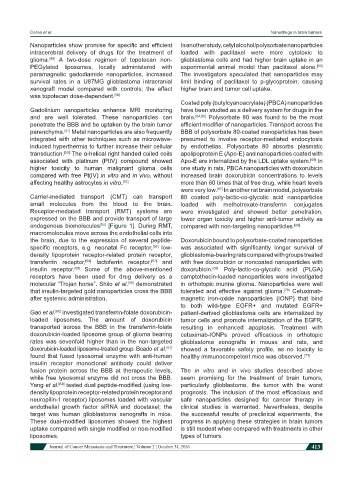Page 423 - Read Online
P. 423
Cerna et al. Nanodrugs in brain tumors
Nanoparticles show promise for specific and efficient In another study, cetyl alcohol/polysorbate nanoparticles
intracerebral delivery of drugs for the treatment of loaded with paclitaxel were more cytotoxic to
glioma. A two-dose regimen of topotecan non- glioblastoma cells and had higher brain uptake in an
[49]
PEGylated liposomes, locally administered with experimental animal model than paclitaxel alone.
[63]
paramagnetic gadodiamide nanoparticles, increased The investigators speculated that nanoparticles may
survival rates in a U87MG glioblastoma intracranial limit binding of paclitaxel to p-glycoprotein, causing
xenograft model compared with controls; the effect higher brain and tumor cell uptake.
was topotecan dose-dependent. [50]
Coated poly (butylcyanoacrylate) (PBCA) nanoparticles
Gadolinium nanoparticles enhance MRI monitoring have been studied as a delivery system for drugs in the
and are well tolerated. These nanoparticles can brain. [64,65] Polysorbate 80 was found to be the most
penetrate the BBB and be uptaken by the brain tumor efficient modifier of nanoparticles. Transport across the
parenchyma. Metal nanoparticles are also frequently BBB of polysorbate 80-coated nanoparticles has been
[51]
integrated with other techniques such as microwave- presumed to involve receptor-mediated endocytosis
induced hyperthermia to further increase their cellular by endothelias. Polysorbate 80 absorbs plasmatic
transduction. The α-helical right handed coiled coils apolipoprotein E (Apo-E) and nanoparticles coated with
[52]
associated with platinum (PtIV) compound showed Apo-E are internalized by the LDL uptake system. In
[66]
higher toxicity to human malignant glioma cells one study in rats, PBCA nanoparticles with doxorubicin
compared with free Pt(IV) in vitro and in vivo, without increased brain doxorubicin concentrations to levels
affecting healthy astrocytes in vitro. [53] more than 60 times that of free drug, while heart levels
were very low. In another rat brain model, polysorbate
[67]
Carrier-mediated transport (CMT) can transport 80 coated poly-lactic-co-glycolic acid nanoparticles
small molecules from the blood to the brain. loaded with methotrexate-transferrin conjugates
Receptor-mediated transport (RMT) systems are were investigated and showed better penetration,
expressed on the BBB and provide transport of large lower organ toxicity and higher anti-tumor activity as
endogenous biomolecules [Figure 1]. During RMT, compared with non-targeting nanoparticles. [68]
[54]
macromolecules move across the endothelial cells into
the brain, due to the expression of several peptide- Doxorubicin bound to polysorbate-coated nanoparticles
specific receptors, e.g. neonatal Fc receptor, low- was associated with significantly longer survival of
[55]
density lipoprotein receptor-related protein receptor, glioblastoma-bearing rats compared with groups treated
transferrin receptor, lactoferrin receptor, and with free doxorubicin or noncoated nanoparticles with
[57]
[56]
[69]
[58]
insulin receptor. Some of the above-mentioned doxorubicin. Poly-lactic-co-glycolic acid (PLGA)
receptors have been used for drug delivery as a camptothecin-loaded nanoparticles were investigated
molecular “Trojan horse”. Shilo et al. demonstrated in orthotopic murine glioma. Nanoparticles were well
[59]
that insulin-targeted gold nanoparticles cross the BBB tolerated and effective against glioma. Cetuximab-
[70]
after systemic administration. magnetic iron-oxide nanoparticles (IONP) that bind
to both wild-type EGFR+ and mutated EGFR+
Gao et al. investigated transferrin-folate doxorubicin- patient-derived glioblastoma cells are internalized by
[60]
loaded liposomes. The amount of doxorubicin tumor cells and promote internalization of the EGFR,
transported across the BBB in the transferrin-folate resulting in enhanced apoptosis. Treatment with
doxorubicin-loaded liposome group of glioma bearing cetuximab-IONPs proved efficacious in orthotopic
rates was sevenfold higher than in the non-targeted glioblastoma xenografts in mouse and rats, and
doxorubicin-loaded liposome-treated group. Boado et al. showed a favorable safety profile, as no toxicity to
[61]
found that fused lysosomal enzyme with anti-human healthy immunocompetent mice was observed. [71]
insulin receptor monoclonal antibody could deliver
fusion protein across the BBB at therapeutic levels, The in vitro and in vivo studies described above
while free lysosomal enzyme did not cross the BBB. seem promising for the treatment of brain tumors,
Yang et al. tested dual peptide-modified (using low- particularly glioblastoma, the tumor with the worst
[62]
density lipoprotein receptor-related protein receptor and prognosis. The inclusion of the most efficacious and
neuropilin-1 receptor) liposomes loaded with vascular safe nanoparticles designed for cancer therapy in
endothelial growth factor siRNA and docetaxel; the clinical studies is warranted. Nevertheless, despite
target was human glioblastoma xenografts in mice. the successful results of preclinical experiments, the
These dual-modified liposomes showed the highest progress in applying these strategies in brain tumors
uptake compared with single modified or non-modified is still modest when compared with treatments in other
liposomes. types of tumors.
Journal of Cancer Metastasis and Treatment ¦ Volume 2 ¦ October 31, 2016 413

